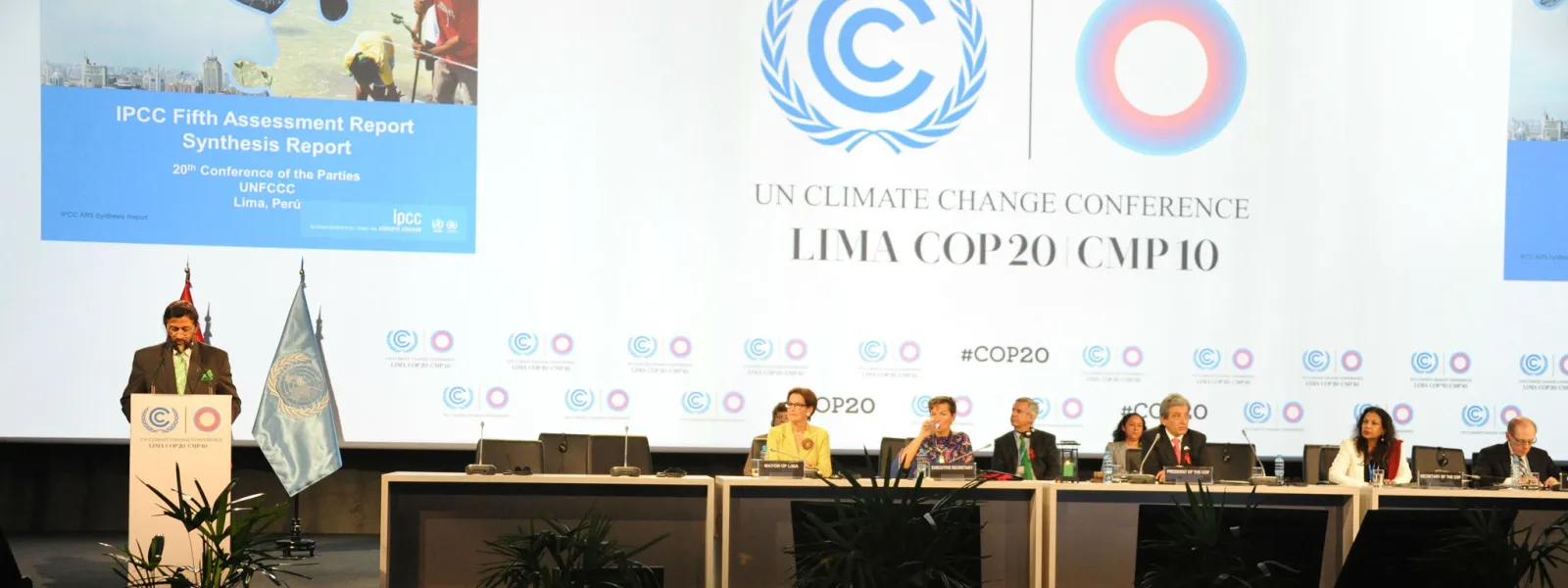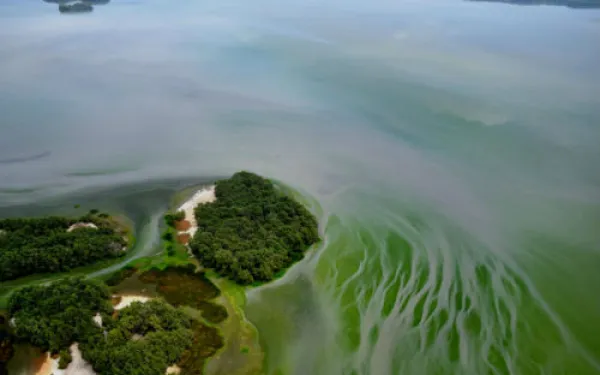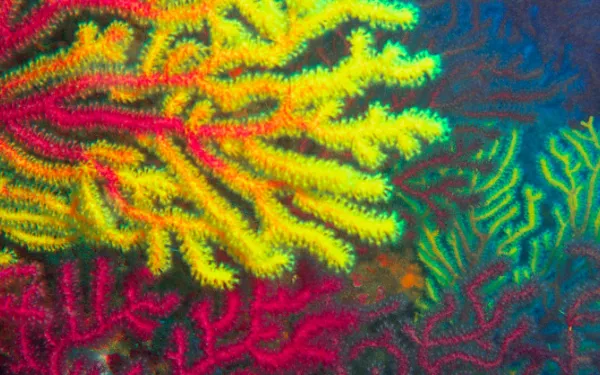
Project
Foto: UNFCCCSiguiendo las negociaciones climáticas en la ONU
Los fenómenos derivados de los cambios en el clima son cada vez más extremos e impactan con mayor dureza a comunidades de países en desarrollo. Vigente desde 1994, la Convención Marco de las Naciones Unidas sobre el Cambio Climático establece acciones para limitar el incremento de la temperatura promedio global y enfrentar los efectos de la crisis climática.
Los países parte de la Convención y del Acuerdo de París se reúnen cada año en la llamada Conferencia de las Partes (COP) para revisar sus compromisos, los avances en el cumplimiento de los mismos y los desafíos pendientes en la lucha global contra la crisis climática.
El Acuerdo de París fue adoptado en la COP21 de 2015. Busca fortalecer la respuesta mundial ante la emergencia climática, estableciendo un marco común de trabajo para todos los países en función de sus capacidades y mediante la presentación de Contribuciones Nacionalmente Determinadas (NDC) que permitan:
- Limitar el aumento de las temperaturas globales a 2°C en comparación con los niveles preindustriales y continular los esfuerzos para limitarlo a 1,5°C;
- Aumentar la capacidad de los países para adaptarse a los impactos del cambio climático; y
- Garantizar que el financiamiento responda al objetivo de reducir las emisiones de gases de efecto invernadero.
Nuestras áreas de trabajo
CRISIS CLIMÁTICA Y DERECHOS HUMANOS
La crisis climática, por su carácter transversal, tiene repercusiones en distintos ámbitos, geografías, contextos y personas. En ese sentido, el preámbulo del Acuerdo de París señala que es obligación de los Estados "respetar, promover y tener en cuenta sus respectivas obligaciones relativas a los derechos humanos, el derecho a la salud, los derechos de los pueblos indígenas, las comunidades locales, los migrantes, los niños, las personas con discapacidad y las personas en situaciones vulnerables y el derecho al desarrollo, así como la igualdad de género, el empoderamiento de la mujer y la equidad intergeneracional".
A través del litigio climático y la incidencia política, AIDA trabaja para lograr una transición energética justa y respetuosa de los derechos humanos y con enfoque de género.
AIDA en las COP
COP25: Chile-Madrid 2019
En la COP25, celebrada en Madrid, España, abogamos por la inclusión de la perspectiva de derechos humanos en diversos temas de la agenda. Promovimos la incorporación de amplias salvaguardas socioambientales en la reglamentación del artículo 6 del Acuerdo de París, referido a los mercados de carbono. Seguimos de cerca la adopción del Plan de Acción de Género, así como la Red de Santiago, creada “para catalizar la asistencia técnica […] en países en desarrollo que son particularmente vulnerables a los efectos adversos del cambio climático”. Impulsamos además la inclusión en los compromisos climáticos de los países de metas ambiciosas y medibles de reducción de los contaminantes climáticos de vida corta.
COP26: Glasgow 2021
AIDA asistió a la COP26 en Glasgow, Escocia, llevando la voz de América Latina. Tras la cancelación de las negociaciones en 2020, la COP26 generó un momento importante para retomar las acciones de incidencia en cuanto al aumento de la ambición climática y el cierre del libro de reglas del Acuerdo de París. AIDA abogó por la inclusión de los más altos estándares de derechos humanos en las decisiones relativas a los mercados de carbono, el financiamiento climático y la regulación de las pérdidas y daños. Durante nuestra participación, brindamos información de fácil acceso sobre estos temas a nuestros aliados y socios en la región. Además, expusimos los avances del litigio climático en América Latina junto con nuestros aliados de Climate Action Network (CAN) y Climate Action Network Latin America (CANLA), entre otras otras redes y grupos de trabajo.
Proyectos relacionados

La Ciénaga Grande de Santa Marta
Quisiera dedicar este post a las personas que viven en y que trabajan por proteger La Ciénaga Grande de Santa Marta, Colombia. Hace unas semanas, gracias a Thomas Ankersen y Juan Pablo Sarmiento, aprendí sobre este sitio maravilloso que requiere protección urgente. El nombre oficial de este Parque Nacional es Santuario de Flora y Fauna Ciénaga Grande de Santa Marta. Está localizado entre Santa Marta y Barranquilla, pertenece a la jurisdicción de Sitio Nuevo. Es un humedal protegido por la Convención sobre los Humedales de Importancia Internacional (conocida como la Convención de Ramsar), un tratado internacional que sirve de "marco para la acción nacional y la cooperación internacional para la conservación y el uso racional de los humedales y sus recursos". Caracterizada por su rica diversidad de flora y fauna, La Ciénaga Grande alberga mamíferos como el ponche (Hydrochaerishydrochaeris) y la zorra manglera (Procyon lotor); reptiles como la tortuga icotea (Chrysemys scripta) y el caimán aguja (Crocodylus acutus); aves como el pato cuervo o longuillo (Phalacrocorax olivaceus olivaceus) y el pato aguja (Anhinga anhinga); y 53 especies de fauna íctica (peces presentes en un determinado lugar marino o fluvial); entre mucha otra variedad de fauna. Además, los bosques de manglar y húmedal que caracterizan la flora del lugar proveen beneficios incalculables para Colombia y el mundo: una hectárea de manglar captura hasta 50 veces más dióxido de carbono que una de bosque. Otro rasgo de la Ciénaga Grande es que en ella hay; pueblos palafíticos (vivienda en el agua) que se extienden por 26,810 hectáreas protegidas por bosques de manglar y humedal. Las 2,500 personas que viven allí dependen de la pesca para subsistir y, en los últimos años, han enfrentado serios retos para capturar peces pues han habido brotes de matanza de peces. Cientos de ellos han aparecido muertos. Los pobladores sufren además la falta de acceso al agua dulce (ni siquiera potable), al sistema de salud y a la seguridad social. Ello guarda relación con el cierre de la entrada de agua potable por desvíos para beneficio de la agricultura. La falta total de agua potable y/o el limitado abastecimiento de ésta han afectado la salinidad del agua y la calidad de vida de los pobladores. La Ciénaga Grande ha marcado mis pensamientos desde hace semanas. Aparte de ser un sitio único por su riqueza biológica, las personas que viven allí son admirables y requieren con urgencia una mejora en sus condiciones de vida. En el 2000 superaron una masacre paramilitar que ha forjado aún más su carácter perseverante. Hoy en día, lo que muchos de nosotros damos por sentado: abrir el grifo y llenar un vaso con agua, o la posibilidad de llegar con un médico en 20 o 30 minutos, es un lujo en la vida diaria de estas 2,500 personas. A lo largo de los años, he visto como el derecho ambiental internacional puede ser utilizado para proteger la riqueza biológica y reducir los impactos que el daño ambiental puede causar en las personas. Estoy segura entonces que pronto escribiré contándoles avances sobre este sitio y sus admirables habitantes.
Leer más
La Protección de los Arrecifes de Coral en México
Este informe aborda la importancia de los arrecifes de coral en el mundo —particularmente en México— y explora casos de estudio. Describe tratados y obligaciones internacionales relevantes, y dirige la mirada a las mejores prácticas de los países de la región en busca de inspiración. Con este informe, AIDA busca dar a conocer a autoridades, manejadores de sitio y sociedad civil las amenazas a los arrecifes de coral y proporcionar una agenda de oportunidades para su protección. Las conclusiones del reporte apuntan a que el manejo inadecuado de los arrecifes de coral ocasiona la pérdida de los beneficios económicos que brindan. Y las recomendaciones surgen para que las autoridades nacionales, organizaciones de la sociedad civil e individuos apoyen el fortalecimiento de la legislación existente para proteger a los arrecifes. El cuerpo de recomendaciones que el informe contiene, proviene del análisis de la legislación actual y los compromisos internacionales que México adquirió con la firma de tratados ambientales para la conservación de los corales. Las acciones separadas ayudan a evitar la degradación de los arrecifes de coral, pero en conjunto constituyen un plan de acción. Estas acciones abarcan desde la creación de un consejo o comisión intersecre-tarial hasta la elaboración de una política nacional para la protección y conservación de los arrecifes coralinos. Descarga el informe
Leer másOrganizaciones solicitan que la CIDH inste al Estado colombiano a declarar la moratoria de proyectos minero-energéticos y a constituir una Mesa de Trabajo con afectados y autoridades
Pidieron también que la Comisión Interamericana de Derechos Humanos (CIDH) inste al Estado a atender adecuadamente a las víctimas de desplazamiento forzado a causa de la implementación de proyectos de "desarrollo" e intervenga para que se abra un proceso de diálogo entre víctimas y autoridades para adoptar soluciones efectivas al problema. Washington D.C, EE.UU. En una audiencia celebrada el lunes pasado ante la Comisión Interamericana de Derechos Humanos (CIDH) en el marco de su 153º Periodo de Sesiones, organizaciones y movimientos sociales solicitaron a este órgano internacional, instar al Estado Colombiano a reconocer el desplazamiento forzado a causa de la implementación de proyectos de "desarrollo" como una violación de derechos humanos que debe ser prevenida y atendida. Además pidieron verificar esta grave situación en los territorios impactados mediante una visita. Las organizaciones expresaron su profunda preocupación por la situación de riesgo en la que se encuentran personas y comunidades que defienden su territorio y entorno natural. Ello ha derivado en el asesinato de 13 personas, la desaparición de una y amenazas a 25 personas que defienden los ríos en el país, incluyendo el reciente asesinato del líder comunero del pueblo Nasa, opositores a la mina la Colosa y una grave amenaza a un gobernador indígena de Cordoba. Expusieron casos concretos en los que megaproyectos han destruido territorios, ecosistemas, culturas ancestrales, causando daños irreparables como contaminación y generando desplazamiento forzado de poblaciones. Los solicitantes presentaron ante la CIDH tres causas principales que favorecen el desplazamiento forzado por proyectos: 1. La estrecha relación entre el conflicto armado y la implementación de megaproyectos; 2. La flexibilización y violación de normas en la autorización e implementación de proyectos, y 3. Los impactos directos por la puesta en marcha de estos. Señalaron que la violencia sociopolítica ha facilitado la implementación de proyectos mineros e hidroeléctricos, provocando el éxodo de personas de sus territorios y la apropiación de los mismos por parte de empresas. “El paramilitar Salvatore Mancuso reconoció que tres mil personas de la zona de Córdoba fueron desplazadas porque necesitaban esas tierras libres para la construcción de represas y que había que abrirle paso a los megaproyectos”, denunciaron. Indicaron además que la ejecución de los megaproyectos en Colombia imposibilita los procesos de verdad, justicia, reparación y garantías de no repetición de las víctimas del conflicto armado y del desarrollo. Adicionalmente, señalaron que el Estado está haciendo uso arbitrario de figuras jurídicas legales como la declaratoria de utilidad pública para dar vía libre a estos proyectos, sin considerar los impactos en derechos humanos y en el ambiente, asuntos también de interés público, lo que en la práctica se ha convertido en un mecanismo de expropiación o despojo legal, y en consecuencia, causal de desplazamiento forzado. Los megaproyectos están afectando gravemente los territorios y las culturas ancestrales, causando daños irreparables como la contaminación ambiental que están provocando desplazamientos de poblaciones. Están causas, que han generado por lo menos 200.000 desplazados víctimas de la implementación de proyectos hidroeléctricos, fundamentan la petición realizada por las organizaciones de que sea declarada la moratoria de los megaproyectos de minería y de hidroeléctricas como única garantía de protección y prevención de mayores vulneraciones de los derechos, hasta tanto no se evalúe estructuralmente la política y se garanticen los derechos fundamentales de los afectados. Finalmente, las organizaciones pidieron la intervención de la CIDH para que en Colombia se instale de inmediato una Mesa Integrada, donde participen los afectados, con el propósito de debatir la política minero energética y construir un modelo que no propicie el desarraigo y responda a las necesidades de las comunidades, y tenga en cuenta las advertencias realizadas por la Corte Constitucional y la Contraloría General de la Republica sobre la necesidad de definir otras formas sustitutivas de generación de energía como las estipuladas por la Comisión Mundial para Represas.
Leer más